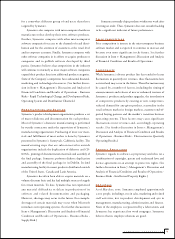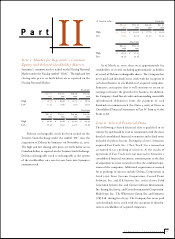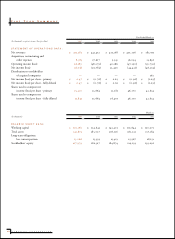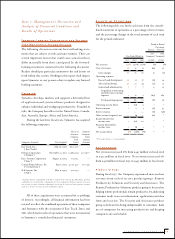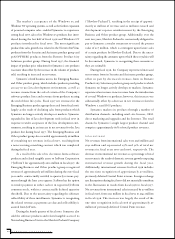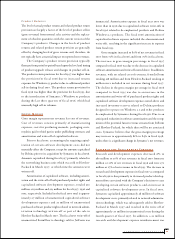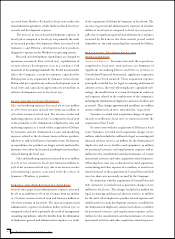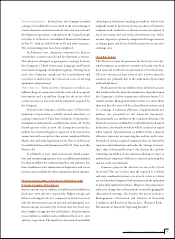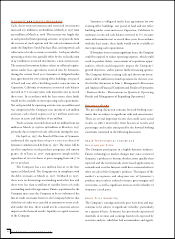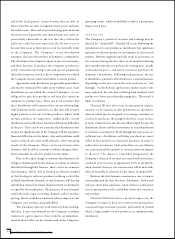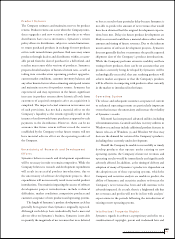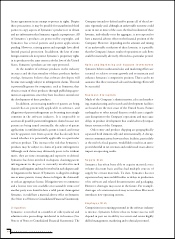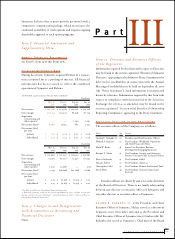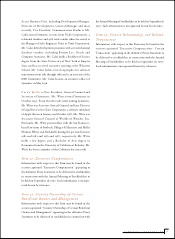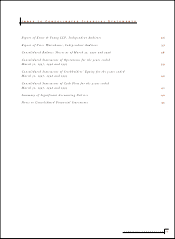Symantec 1997 Annual Report Download - page 27
Download and view the complete annual report
Please find page 27 of the 1997 Symantec annual report below. You can navigate through the pages in the report by either clicking on the pages listed below, or by using the keyword search tool below to find specific information within the annual report.
cant adverse effect on the trading price of the Company’s
common stock. This may occur again in the future.
Additionally, as a significant portion of the Company’s
revenues often occur late in the quarter, the Company may
not learn of revenue shortfalls until late in the fiscal quarter,
which could result in an even more immediate and adverse
effect on the trading price of the Company’s common stock.
Personal Computer and Hardware Growth Rates
Fluctuations in customer spending from software to hardware
as the result of technological advancements in hardware or
price reductions of hardware have in the past and may in the
future result in reduced revenues which would have a material
adverse effect on operating results.
Fluctuations in Quarterly Operating Results
While Symantec’s diverse product line has tended to lessen
fluctuations in quarterly net revenues, these fluctuations have
occurred in the past and are likely to occur in the future.
These fluctuations may be caused by a number of factors,
including the introduction of competitive products by new
competitors, reduced demand for any given product, season-
ality in the retail software market, the market’s transition
between operating systems, the impact of the Internet
and general economic conditions. These factors may cause
significant fluctuations in net revenues and, accordingly,
operating results.
Management of Expanding Operations
Symantec continually evaluates its product and corporate
strategy and has in the past and will in the future undertake
organizational changes and product and marketing strategy
modifications which are designed to maximize market
penetration, maximize use of limited corporate resources and
develop new products and product channels. These organi-
zational changes increase the risk that objectives will not be
met due to the allocation of valuable resources to implement
changes. Further, due to the uncertain nature of any of these
undertakings, there can be no assurance that these efforts will
be successful or that the Company will realize any benefit
from these efforts.
Symantec has completed a number of acquisitions and
may acquire other companies in the future. Acquisitions
involve a number of special risks, including the diversion of
management’s attention to assimilation of the operations and
personnel of the acquired companies in an efficient and
timely manner, the retention of key employees, the difficulty
of presenting a unified corporate image, the coordination of
research and development and sales efforts and the integra-
tion of the acquired products.
The Company has lost certain key employees of
acquired companies, and, in some cases, the assimilation of
the operations of acquired companies took longer than
initially had been anticipated by the Company. In addition,
because the employees of acquired companies have frequently
remained in their existing, geographically diverse facilities,
the Company has not realized certain economies of scale that
might otherwise have been achieved.
Symantec typically incurs significant expenses in connec-
tion with acquisitions, which have a significant adverse impact
on the Company’s profitability and financial resources. These
expenses may have a significant adverse impact on the
Company’s future profitability and financial resources.
Foreign Operations
A significant portion of Symantec’s revenues, manufacturing
costs and marketing is transacted in foreign currencies. As a
result, the Company may be materially and adversely affected
by fluctuations in currency exchange rates, as well as increases
in duty rates, exchange or price controls or other restrictions
on foreign currencies. The Company’s international opera-
tions are subject to certain risks common to international
operations, such as government regulations, import restric-
tions, currency fluctuations, repatriation restrictions and, in
certain jurisdictions, reduced protection for the Company’s
copyrights and trademarks.
Price Competition
Price competition is intense in the microcomputer business
software market and is expected to continue to increase and
become even more significant in the future, resulting in
reduced profit margins. Should competitive pressures in the
industry continue to increase, Symantec may be required to
reduce software prices and/or increase its spending on sales,
marketing and research and development as a percentage of
net revenues, resulting in lower profit margins. There can be
no assurance these changes will be successful.
Distribution Channels
Approximately 34% of the Company’s net revenues in fiscal
1997 were from sales to two large retail distributors. These
customers tend to make the majority of their purchases at the
25
SYMANTEC CORPORATION


